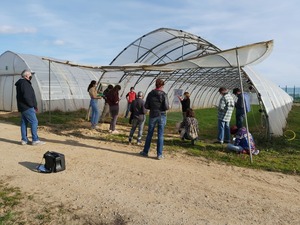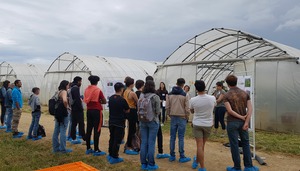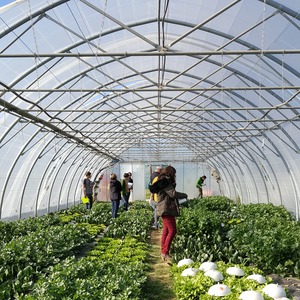Case study 25: France: Enhancing crop diversification of vegetable food chains in the Roussillon area through joined actions from farms to market
Cluster 5: Diversification of vegetable cropping systems
The Roussillon region is focused on both local value chains and export-oriented vegetable production to Northern France and Europe. It therefore faces economic, technical and logistic challenges. Diversification was identified as a lever to support production in the region, for instance, to deal with pest problems due to monocropping, and as an economic opportunity.



What were the main problems underlying the emergence of the case study?
Fresh market vegetable production is a historic and emblematic farming and economic activity in the Roussillon plain. From the sixties to the nineties, vegetable production and marketing mainly targeted long supply chains and were specialized in a small range of products: lettuce, artichoke, tomato and cucumber. Today, vegetable production in the area is facing several difficulties. Competition from products grown in other production areas (other French regions, southern Europe, northern Africa) is strong and reinforced by the presence of the Saint Charles international hub for marketing, transporting and logistics of fruits and vegetables in the case study territory. Prices are very volatile as a function of the weather conditions and/or of the supply and demand ratio. Perpignan and the surroundings villages are sprawling and farming areas decreasing. As a solution to the economic difficulties faced by some producers, short and/or local supply chains have been growing over the last twenty years and meet consumer demand. They usually involve a larger range of products than long supply chains. Local demand is however limited compared to potential production and irregular due to seasonal tourism. Today, short/local and long supply chains coexist in the territory, which is seen as a strength by local stakeholders. Stakeholders however are unhappy with the lack of coordination between the various supply chains in the territory.
In this context, crop diversification can be seen as an opportunity to maintain significant and dynamic vegetable production in the Roussillon plain and the case study aims to facilitate its implementation. Crop diversification in vegetable production systems is indeed challenging. As products are mostly sold fresh with little or no storage, planning is critical to meet demand whereas prices are very volatile. However, two to three crops grown quickly one after the other on the same field within a year with multiple steps from ‘farm to fork’ (seeding, transplanting, fertilising, watering, pruning and trellising plants, managing pests, harvesting) makes planning tricky. In addition, producers are particularly risk adverse for at least two reasons: First, production costs are high due to a high share of labour costs in low-mechanised systems. Second, marketing standards are very strict and biotic or abiotic damage can quickly affect products and generate a large amount of waste if not addressed in a timely manner by appropriate crop management techniques.
How was the problem addressed and which actors were involved?
In order to facilitate the implementation of diversified vegetable systems, a partnership was launched between the INRAE agroecological vegetable systems experimental facility, dedicated to protected vegetable production systems, and the fruit & vegetable department of the Pyrénées-Orientales Chamber of Agriculture. Case study 25 involved farmers, advisors and marketers. The farmers manage middle-sized farms dedicated totally or partly to vegetable production. They are involved in crop diversification and are converting totally or partly to organic farming. They combine short and long value chains to sell their products. The marketers sell diverse conventional and/or organic and products. The case study aimed to connect farmers and value chain actors to enhance mutual understanding and coordination. A key challenge stated by the stakeholders is to identify innovative ways of thinking and acting beyond business as usual.
Solution investigated
Three types of actions were implemented within the case study to enhance the development of diversified vegetable cropping systems: (1) capitalise, develop and share knowledge and experience on diversified cropping systems, (2) if needed, adapt and test method(s) or tool(s) to facilitate crop diversification planning and management at the farm and value chain scales, and (3) stimulate reflections, which aim to design marketing strategies that are better adapted to crop diversification.
Expected outcome
An entry point in the case study was to give farmers the opportunity to step back and assess the strengths and weaknesses of their systems. The case study also developed resources useful for designing, planning and managing diversified vegetable cropping systems. The case study also aimed to enhance coordination both between farmers and between farmers and value chain actors in order to secure outlets for products coming from diversified vegetable systems.
Relevance for the DiverIMPACTS goals
Case study 25 aims to sustain the diversification of vegetable food chains in the Roussillon plain. Crop diversification is the main entry point, which can include rotation, intercropping and multiple cropping as well as the application of green manure. In case study 25, to achieve the full potential of diversification, as proposed by DiverIMPACTS, value chains should be able to create value for the “Roussillon diversified vegetable basket”. Stakeholders have highlighted the need to target local and regional markets as well as more distant ones (national and possibly European markets). They have also stated that a key challenge is to identify ways of thinking and acting beyond business as usual, ensuring consistency with the aim of DiverIMPACTS to propose innovations to remove lock-ins to crop diversification from farmers to consumers.
Case study legacy
The 3 types of actions implemented in the case study continue in different forms:
- On May 2022, INRAE agroecological vegetable systems experimental facility organised a diversification day where they presented results from DiverIMPACTS field experiment 10, other experiments dealing with diversification, as well as results on the design of diversified rotations. This day supported the objective of capitalising and sharing knowledge on diversified vegetable systems. The experimental facility will continue to organise such visits and exchanges. In addition, the experimental facility is coordinating the ForCES project within INRAE, which aims to establish a method to facilitate the formalisation of knowledge for action resulting from agroecological production system experiments. DiverIMPACTS field experiment 10 will support the development and application of this method.
- The case study was an opportunity to start work on adapting the ROTAT tool to protected vegetable systems in order to facilitate the design of diversified rotations. ROTAT generates all possible rotations from a list of crops and agronomic constraints and then evaluates them in a multicriteria manner. Case study participants provided the expertise needed to adapt the model, but also to discuss its strengths and limitations. Further developments are planned in the DEFIBIO project financed by INRAE and the French region of Occitanie.
- The case study made it possible to specify and prioritise the barriers to the marketing of products coming from diversified vegetable systems. From a commercial point of view, this diversification implies marketing small volumes of a variety of products. These small volumes generate additional costs and investments that are currently difficult to reduce or compensate for through sales. This difficulty is reinforced by the fact that relationships between producers or cooperatives on the one hand, and distributors on the other, are structured mainly on a product-by-product basis and not for a basket of products. Finally, the markets associated with so-called diversification crops are seen as uncertain or limited. The case study allowed for exchanges on the levers that would make it possible to overcome these barriers. The INRAE experimental facility and the Pyrénées-Orientales Chamber of Agriculture are currently involved in the INTERLUDE project financed by the French programme Ecophyto. The project builds on the work of the case study with the aims to design partnerships between local vegetable food chain stakeholders in order facilitate the marketing of products resulting from diversification with the joint objective of reducing the use of phytosanitary products while improving the added value of the products.
Further information
Links
- zenodo.org: Diversified rotations in protected vegetable production systems including cover crops
- zenodo.org: Diversified rotations in protected vegetable production systems
- zenodo.org: Multi-species summer cover crop in protected vegetable systems
- sciencedirect.com: Dogliotti S., Rossing W.A.H., van Ittersum M.K., 2003. ROTAT, a tool for systematically generating crop rotations. European Journal of Agronomy 19: 239-250.
Contact
- Claire Lesur-Dumoulin, INRAE, case study leader
- Amélie Lefèvre, INRAE, case study monitor
 tap and then scroll down to the Add to Home Screen command.
tap and then scroll down to the Add to Home Screen command.